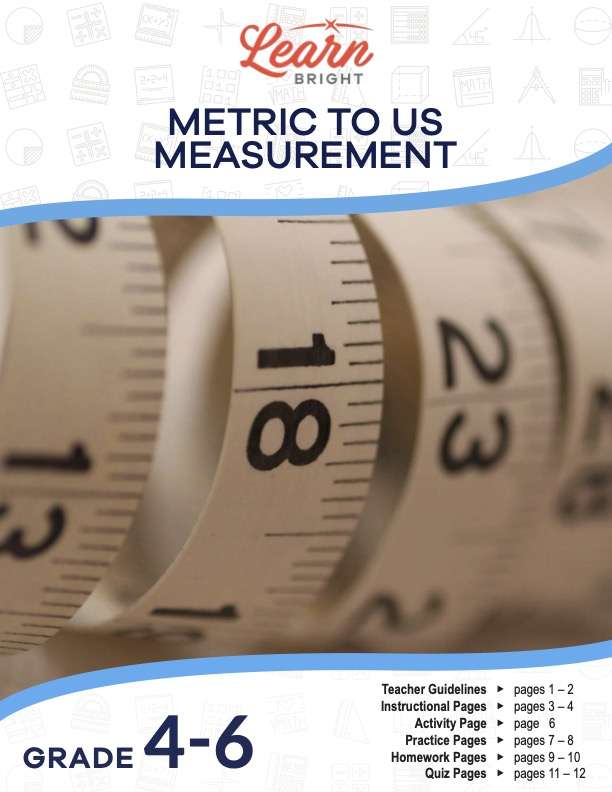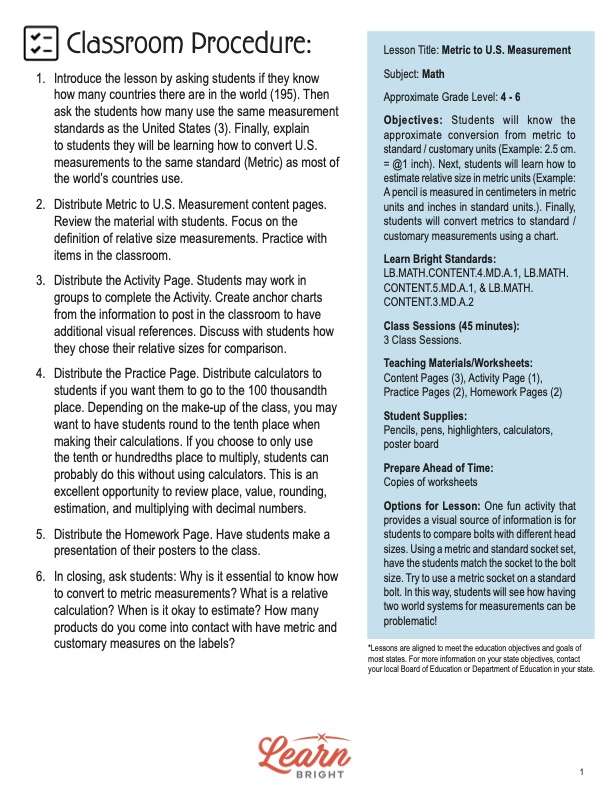Description
What our Metric to US Measurement lesson plan includes
Lesson Objectives and Overview: Metric to US Measurement introduces students to the metric system and how it relates to US measurements (standard). Conversion charts from US Standard to Metric are included for distance, area, volume and weight. At the end of the lesson, students will be able to convert from metric to US measurement. This lesson is for students in 4th grade, 5th grade, and 6th grade.
Classroom Procedure
Every lesson plan provides you with a classroom procedure page that outlines a step-by-step guide to follow. You do not have to follow the guide exactly. The guide helps you organize the lesson and details when to hand out worksheets. It also lists information in the blue box that you might find useful. You will find the lesson objectives, state standards, and number of class sessions the lesson should take to complete in this area. In addition, it describes the supplies you will need as well as what and how you need to prepare beforehand. The supplies that you will need for this lesson include pencils, pens, highlighters, calculators, and poster board.
Options for Lesson
Included with this lesson is an “Options for Lesson” section that lists a number of suggestions for activities to add to the lesson or substitutions for the ones already in the lesson. One optional addition to this lesson is to have your students compare bolts with different head sizes; using a metric and standard socket set, have the students match the socket to the bolt size. You can also have your students try to use a metric socket on a standard bolt to see what happens.
Teacher Notes
The teacher notes page includes a paragraph with additional guidelines and things to think about as you begin to plan your lesson. This page also includes lines that you can use to add your own notes as you’re preparing for this lesson.
METRIC TO US MEASUREMENT LESSON PLAN CONTENT PAGES
Metric to US Measurement
The Metric to US Measurement lesson plan includes three content pages. The metric system is a system of measurement used in most of the world. This system of measurement uses increments of 10. When you think of decimal numbers in tenths, hundredths, thousandths, and so on, that is what the metric system is based on. For example, 10 millimeters equal one centimeter.
Even though they have different names and measure different things, dry and liquid measurements work the same way mathematically. For example, we use milliliters as a metric measure of a liquid. One teaspoon has approximately five milliliters. That should tell you just how small a milliliter is!
Almost all 195 countries in the world use the metric system of measurement. Only three don’t! The United States is one of the countries that does not use the metric system. Instead, we use the standard (also called the imperial or customary) system of measurement. Instead of increments of 10, the standard system uses increments of 12. For example, 12 inches equals one foot. On a ruler, each line represents a tenth of an inch. Some rules come in different increments. Some show fourths, eighths, twelfths, or even sixteenths. It can be challenging to measure small sizes using the standard system. In fact, most modern tape measures and rulers have both the standard and metric units in order to be as accurate as possible.
Measuring liquids can also be difficult with the standard system, where liquid measurements being with the ounce. A teaspoon holds approximately 16/100ths of an ounce of liquid. It’s not very simple to understand!
Having different systems of measurement for weight can cause problems. Because most places in the world use the metric system, businesses in the United States often have to convert transactions to metric units. Many products that you buy probably have metric units on the label. For example, water comes in liter bottles and many cars show kilometers on their speedometers. Pharmacies measure most medicines in metric units. It’s very useful to be able to convert between the systems of measurement.
Sometimes, it’s actually easier to estimate based on relative sizes. We use relative sizes to approximate the size or weight of something in standard and customary units. For example, a liter of soda is approximately the same as a quart. In reality, a liter is a little more than a quart, but we don’t always need to know the exact size. If you want the exact size or weight, you can use a ruler or a scale.
Sometimes, an approximation is all that you need.
For example, say a new kid at school asked you, “How long will it take me to get to my next class?” Instead of using a calculator and the formula that you would need to find the exact answer, you can estimate. They don’t need to know all of the exact measurements and details, they’re just trying not to be late for class. Estimations are a form of relative calculation. When we say that something is relative, we mean that we can understand the question better in comparison with something else.
Relative Measurements (rounded to tenths)
The lesson includes some relative measurements that you can use to convert between systems of measurement. It lists metric units on one side and standard units on the other side.
For length, millimeters (mm) are roughly equal to fractional inches (in), 2.5 centimeters (cm) equal 1 inch (in), 30.5 centimeters (cm) equal 1 foot (ft), 3.2 meters (m) equal 1 yard (yd), and .62 kilometers (km) equal 1 mile (mi).
For weight, 28.3 grams (g) = 1 ounce (oz), 1 kilogram (kg) = 2.2 pounds (lb), and 1 metric ton = 1.1 ton (t).
Finally, for liquid weight, 1 milliliter (ml) = .03 ounce (oz), 240 milliliters (ml) = 1 cup (c), 1 liter (l) = 1.1 quarts (qt), and 3.7 liters (l) = 1 gallon (gal).
It’s easy to estimate which metric unit best fits the standard unit when you consider the relative size. For example, say your teacher wanted to know what metric unit to use to measure the length of a pencil. In the standard system, you would use inches. The relative metric measurement for inches is centimeters (cm). You can then use that information to estimate the length of the pencil in metric units.
You know that a pencil is about seven inches long, and that an inch is approximately 2.5 centimeters. Therefore, you can multiply 2.5 x 7 and get 17.5 centimeters. This means that the pencil is approximately 17.5 centimeters long. You used relative sizes to figure that out!
The lesson closes with a few helpful tables that show the exact conversions between metric and standard units. Students can reference these as needed.
METRIC TO US MEASUREMENT LESSON PLAN WORKSHEETS
The Metric to US Measurement lesson plan includes four worksheets: an activity worksheet, a practice worksheet, a homework assignment, and a quiz. You can refer to the guide on the classroom procedure page to determine when to hand out each worksheet.
RELATIVE SIZE COMPARISON ACTIVITY WORKSHEET
For the activity worksheet, students will choose 10 items. They will then use relative size comparisons to estimate the measurement of each item in metric or standard units.
CONVERSION PRACTICE WORKSHEET
The practice worksheet asks students to fill in the table to convert from metric to US measurement, using a calculator as needed.
POSTER HOMEWORK ASSIGNMENT
For the homework assignment, students will create their own conversion chart. To do this, they will select six items, two for each category: Distance, Volume, and Weight. They will then create a poster showing each conversion and a picture of the item.
QUIZ
This lesson also includes a quiz that you can use to test students’ understanding of the lesson material. For the quiz, students will fill in the table to convert from metric to US measurement.
Worksheet Answer Keys
This lesson plan includes answer keys for the practice worksheet, the homework assignment, and the quiz. If you choose to administer the lesson pages to your students via PDF, you will need to save a new file that omits these pages. Otherwise, you can simply print out the applicable pages and keep these as reference for yourself when grading assignments.









